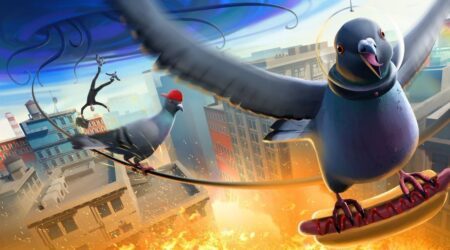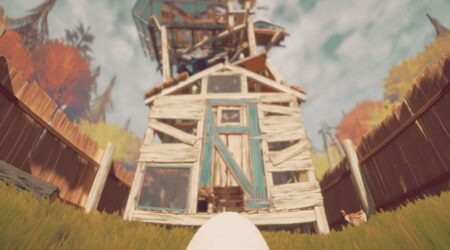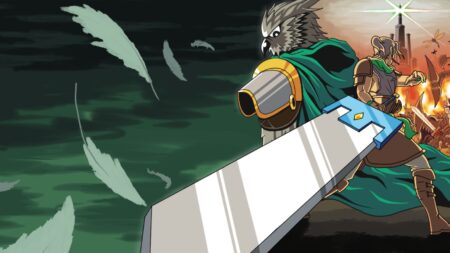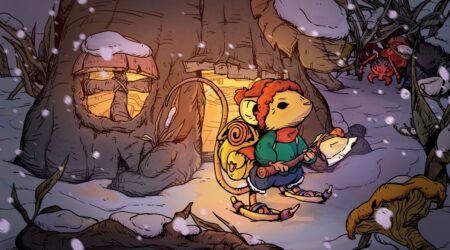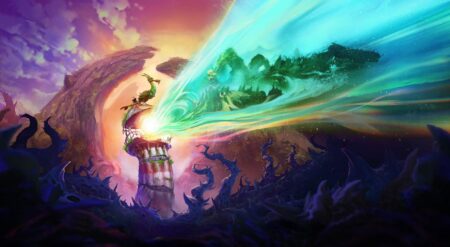South of Midnight is one of the first times I’ve played a game that captured the depth and beauty of the South. While Norco carries its own Southern weight and reverence, the Compulsion Games-adventure title tackles the whimsy and fantasy alive in Southern storytelling and countryside.
Published by Xbox Games Studios, South of Midnight offers platforming and combat that gets close to feeling like a Metroidvania, minus the sidescrolling. The mechanics play well into that genre while pushing a heavy narrative and exploration element that sequesters combat into neat pockets instead of putting enemies throughout every inch of the world. And that world is magnificent.
The story starts with Hazel and her mother preparing for a hurricane. But Hazel is left alone when her home is swept away by a storm, taking her mother, Lacey, with it. Hurricanes and their life-altering damage aren’t new in Southern storytelling, whether influenced by Katrina or Helene. Hazel heads into the storm and unlocks her magical power, Weaving.
Weavers can pull the threads of life and memory from the Grand Tapestry. Deeply rooted in Southern quilting culture, which stitches together stories of families and histories in one object, Hazel explores her newfound Weaver powers, pulling people together and helping them soothe their pain. This power connects her to a long line of Weavers destined to help souls move through the world and move on from trauma. When she encounters Mahalia, a Weaver from the past, she begins to follow her spirit through the toxic waters of the hurricane, learning new abilities as new obstacles appear.
Compulsion Games’ cosmology for South of Midnight is beyond endearing.
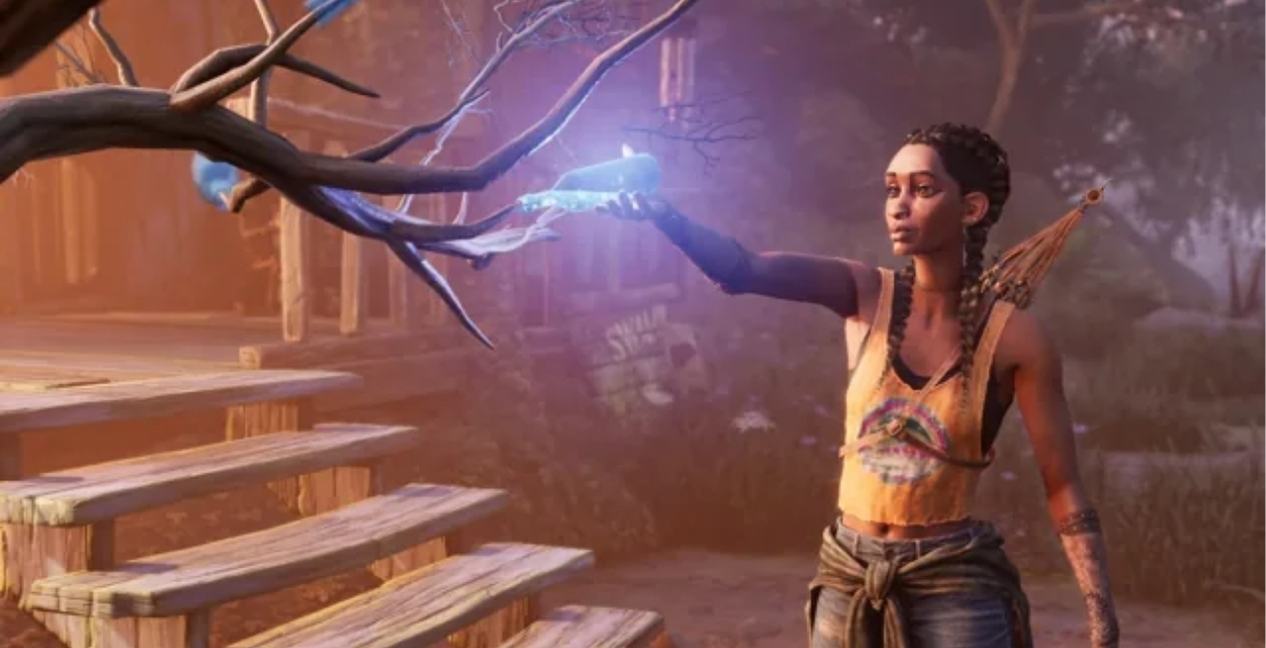
The game’s opening chapters set the expectations for the game. Chapter 3 is where the gameplay begins to take off, with new additions to each subsequent chapter in South of Midnight. Chapter 3 is also when you encounter a giant Catfish, who will serve as your narrator in between chapters and your mentor of sorts as he shepherds you to different locations. One of the primary recurring characters in the game, Catfish, is comedic and endearing in one go. Every character you meet has a special draw about them.
As a weaver, Hazel is a magical mender of broken bonds, tapping into the pain spirits leave behind. The tears that spring up in the world can cause it to rot. In Southern Gothic stories, the festering rot of one bad deed often propels everything around it. Inspired by European Gothic storytelling, this American literary tradition is captured here with all of the idiosyncrasies of the American South and done so without feeling like an uninformed joke.
One of the ways that the rot is captured is through knots in the world that Hazel must undo. They spawn different enemy types, which are called Haints in the game. They all push Hazel into different forms of combat with classic shield, berserker, and AOE-focused types pulling the player into exploring the full range of their kit.
The combat itself is as expected from the adventure genre, primarily localized to one button that forms combos and uses the triggers and bumpers to use special abilities like push, pull, stun, control a Haint with Crouton (your little summonable companion), and an AOE attack that allows you to stun and damage enemies. But the combat isn’t nearly as interesting as how the enemies impact the larger world and fit within the narrative.

Once mastered, enemy encounters are straightforward, even as new enemy types are introduced to the fights as you progress through the story. The really interesting thing is that combat necessitates constant movement using your dash. While in the air, holding ‘B’ allows you to glide, but in combat, it moves you quickly out of the enemy’s way and is the best way to stay alive.
While there are four difficulty options, including one that allows you to skip boss combat altogether, I found myself stuck on even using the custom slider to hit the sweet spot for challenge. For me, the combat’s simplicity meant that I ramped up the difficulty about midway through. The shift wasn’t as great; my health felt lower, and my need to dodge increased.
Additionally, each combat area comes with one Green Strand, which replenishes your health. While health management is one thing, Compulsion has worked in two elements that make combat easier if you need it. The first is that when unraveling the knots left behind by defeated Haints, you will receive marginal health refills, usually correlating to the size of the knot and the creature’s difficulty.
The second element is having a simple targeting assist option. By pushing in the right stick and then moving it between enemies, you can lock on to a target, which helps as you learn to move around more frequently as the game continues.
Combat may be simple, but it does offer a quickness that pays off in the moment.

One of the game’s strongest elements is that your full kit as a Weaver isn’t entirely accessible at the beginning. New abilities, puzzles, and traps pop up as the game progresses and mostly keep things fresh, at least while you’re learning the new mechanic. From exploding mushrooms to poop-spraying sprinklers at a hog farm or an oversized carnivorous plant, you have to pay attention to the world around you, and the game teaches you how.
The largest addition you gain is Crouton. He is one of Hazel’s favorite toys, which she animates to fit into small areas that she can’t. The ability to add a different perspective is ambitious and ultimately well-executed. Aside from Two-Toed Tom, Crouton is the best boi of the game.
But this isn’t a game about combat, and as such, being able to speed through enemy encounters winds up being good to progress through the story, which will take about 15-20 hours depending on how many Floofs you try to find on the paths that don’t take you to your main objective.
South of Midnight also doesn’t focus on exploration. That said, for a linear story that only allows you to progress in one direction, there are many side paths for you to explore. When you take on the number of jumping puzzles throughout the world, you are rewarded with Floofs. The number of which is dictated by the difficulty of making it across the platforming challenge.
The Floofs are exchangeable for new abilities. While I didn’t 100% the Floof hunting, I did complete almost every skill available in the game and collected most of the Health Filaments—collectibles in the world that increase your health bar. Exploration may not be an objective for the game, but the beauty of the landscapes pulls you in to explore. Often, I’d pull up the guiding strand to see where I needed to head next and then actively choose the opposite direction.
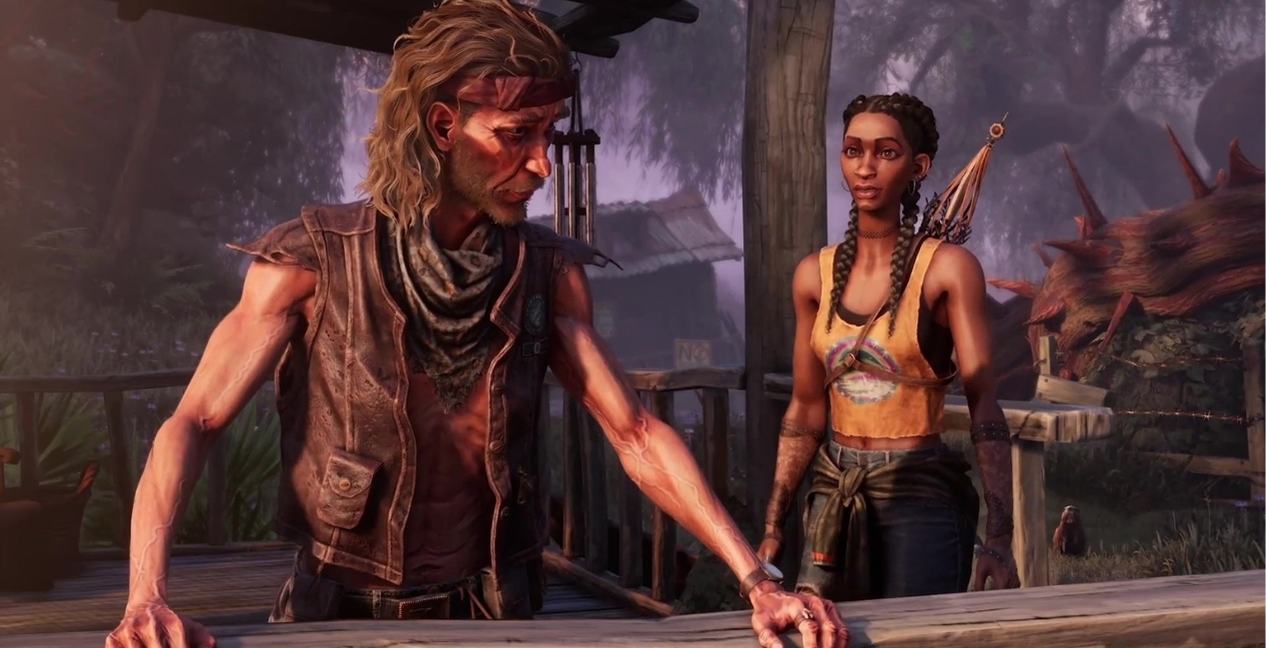
The American South is a beautiful place. While it’s often maligned and stereotyped as backward and uncultured, the reality is that it’s the most diverse region of the United States, with a plethora of cultural traditions that combine Appalachia, Cajun, Creole, French, and a large number of mythologies and folklore of the people who have called the South home.
South of Midnight deeply understands this. While Chickasaw County is located in Mississippi, the game itself references Tennessee, Louisiana, Mississippi, Georgia, and nearly the entire South in bringing its dark fairytale to life.
More importantly, the narrative thrives by bringing Southern Gothic storytelling to players. By engaging with the complex and emotionally heavy elements of social decay and familial betrayal that the genre is known for, the team at Compulsion Games has created a story that belongs with the greats in the literary genre. It contributes to a long tradition of Southern storytelling and does so by expanding what people know about the South. In reality, it’s a magical place.
With a bevy of mythical creatures to fight and help in equal measure, all inspired by Southern myths, cryptids, and folklore, Hazel is always interacting with the cornerstones of the South. More importantly, however, is that each mythical creature is adapted with enough of its myths intact to be familiar but changed enough to capture how it changes based on the interpretations of the generation and medium that engages with it.
Whether that’s Huggin’ Molly, Two-Toed Tom, the rougarou, Kooshma, or even the Devil at the Crossroads, Compulsion Games has reinvented figures that feel original and generational just the same. South of Midnight has one major narrative goal: for Hazel to reunite with her mother. This mother-daughter bond is a strong throughline throughout the game, with family, how we relate to it, and yearn for it, grounding many of the stories Hazel encounters as she soothes the pain of the mythical creatures causing the Great Tapestry to knot.
South of Midnight understands what makes Southern Gothic storytelling enduring.
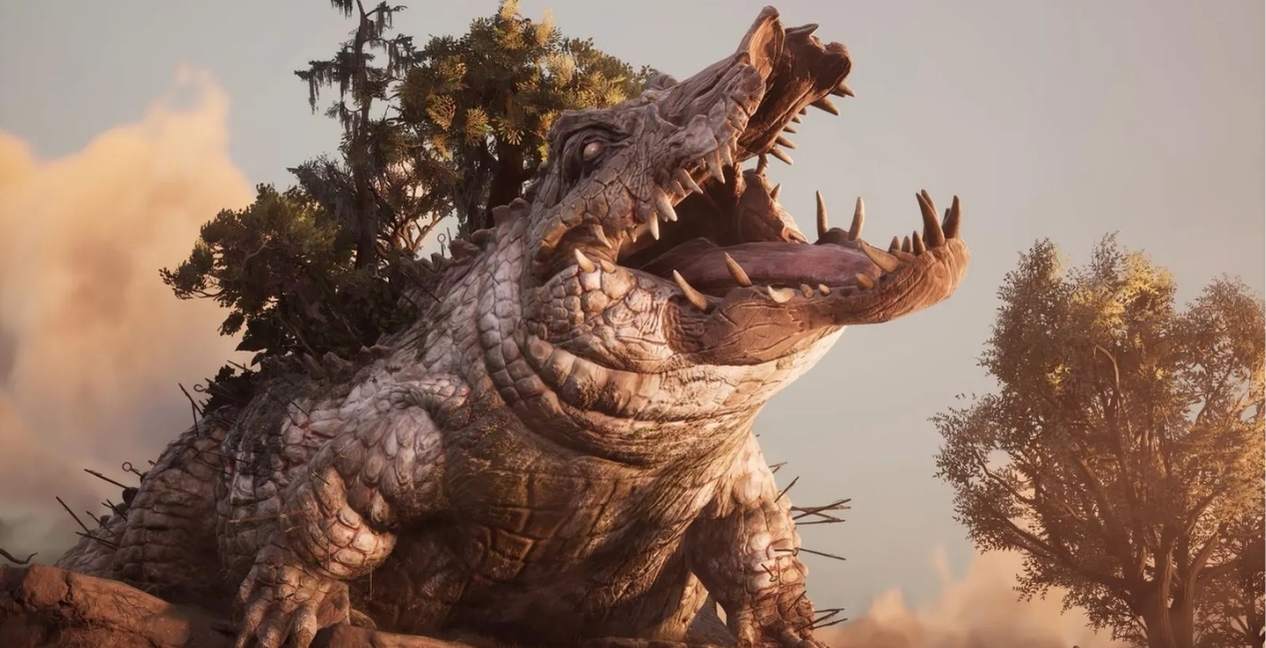
But central to each story is the human element of secrecy, guilt, and fear. Every single chapter is rooted in things left unsaid, sometimes horrible realities that were stamped down into memory, never to be vocalized. Some were done out of the need to survive, and others from selfishness. Still, each and every one of the smaller stories tied to the game’s objectives offers emotional weight.
The game pushes the player toward compassion. The story wants us to understand that we don’t know the pain people are holding or the struggles they’re pushing through, and sometimes, they just need to be met with understanding and given the space to let go.
Hazel’s guilt grows as guilt chips away at different stories throughout South of Midnight. As she sees different families directly or inadvertently harmed because of singular choices, she can’t help but remember that the last thing she did was fight with her mother before her trailer washed away. The weight of that guilt begins to hit Hazel harder and harder as she has to confront the encroaching reality that her mother may truly be lost.
Hazel, as a protagonist, is flawed and quick-tempered, but she loves deeply and offers compassion to absolutely everyone she meets, even if they don’t always deserve it. Guilt is what drives Southern Gothic literature, and that’s alive and well in this game’s story, capturing the very best of how to wield complex emotions.
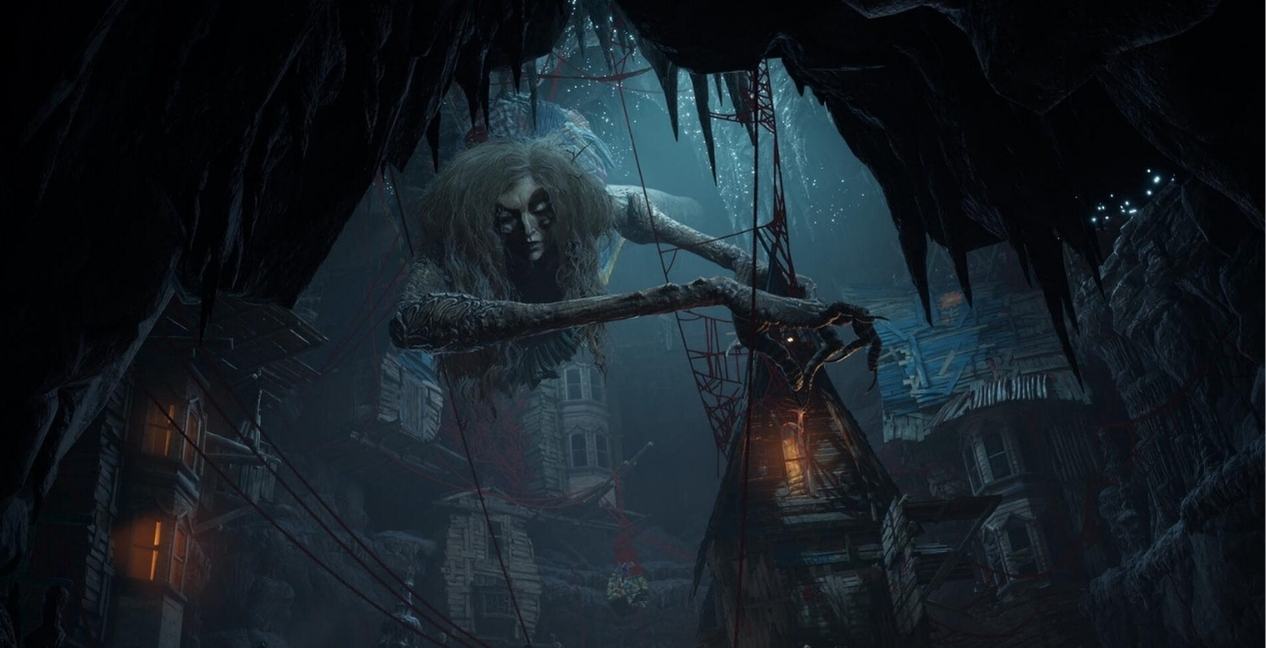
Additionally, I have to commend the South of Midnight narrative team, who take big swings and don’t hold back. Death is a constant in this game. Sometimes, the person deserves it, and other times, they’re too innocent to pull anything but a deep sadness as you find out their circumstances. Where Hazel embraces her compassion, so does the writing team as they work to build empathetic tethers between the player, the circumstances they’re seeing play out, and the tragic characters on the screen.
South of Midnight achieves narrative heights by putting emotion first and pulling together Southern tropes and stereotypes, making them feel at home instead of like a joke. Whether it’s Jolene and her fiery red hair helping people weather the storm, the clearly Appalachian-inspired Itchy keeping a dead town alive, or Beaux’s backstory as a former D1 football player now taking care of the people around him. These are the people you see in Texas, Alabama, Mississippi, Georgia, and the greater South.
Additionally, South of Midnight understands that sometimes resolution doesn’t feel good. It makes the player question the balance between mercy and justice and decide where they fall. And it does so through charismatically acted characters and thoughtfully written dialogue. But the thoughtfulness isn’t just in representing the South as a people with magic and a culture all their own, but rather in leaving its rough edges intact as it pulls it into the spotlight.
One of the game’s most fascinating references to Southern culture, more particularly in folk religion, is how Compulsion Games has approached platforming and puzzle markers. Instead of yellow or white paint, the development team uses blue. The color is significant because throughout the game, Hazel fights Haints, malevolent ghosts in Southern folklore. But Haint Blue keeps them at bay. Haints are known not to cross water, and as such, blue trims, ceilings, and doors are done to keep them away.
It’s a small piece of Southern folklore that comes from Gullah culture, and the attention to that detail is what floored me. While the references in the game are many, it’s the small moments that capture the team’s dedication to representing the world that people know and are often overlooked. More particularly, that much of the culture that runs through the South begins with different traditions kept alive by Black communities in the South, and expands out to define their states and region. Reverence is given and traditions are iterated on beautifully.
South of Midnight’s one flaw is its repetitive game loop, which becomes predictable too quickly.

South of Midnight’s only real stumble is a repetitive game loop. Enter an area, have fights that consist of one to three waves of manageable enemies, fill the bottle around four times, and then perform a platforming run that puts speed first while chased by the game’s big bad’s darkness. Then, have a boss fight to mend the knotted core in the monster on the other end of the fight. It’s a rinse-and-repeat cycle that, while engaging, begins to wane as you reach the game’s halfway point around Chapter 7.
The game is at its best when it breaks from the combat cycle of collecting people’s pain and destroying stigma. It’s at its best when the narration takes the front seat, and combat isn’t forced in. Ultimately, though, South of Midnight isn’t its selling point despite its fun and quick platforming or even its mostly kinetic combat style. Come to South of Midnight for its rich story and its breathtaking art.
From individual character models and creature designs to lush and layered environments, the world of South of Midnight is whimsical, dark, and ultimately a vision of the South fit for any big screen production. In fact, while the subject matter of the quest line stories evokes elements of the darkness in Southern Gothic stories like Eve’s Bayou, the world fits into the vision of the South that highlights Southern storytelling in Big Fish and The Rivals of Amziah King, but with more fairytale flair that pays off.
With its inspiration from stop-motion animation, the game achieves a cinematic feat that I didn’t know was possible. The game’s signature and unique style add to even its smallest moments. While the stop-motion animation is clearly visible in cut-scenes, it’s when you’re walking through burrows as Crouton to complete tasks that it really shines as a substantial departure from what we usually see in games, particularly in Crouton’s movements and the wildlife in the burrows.
However, the stop-motion animation character movements can be slightly jarring in combat if a player isn’t aware of this stylistic choice. It can make the frame rate feel limited, but only in rapid sections of platforming or combat. That said, it is almost essential to turn off the stop-motion animation for those with motion sickness issues. I attempted to play with the effects turned on at various points throughout the game, but the vertigo it induced wasn’t avoidable even when just sprinting through the world. Thankfully, there are multiple accessibility options to adjust the camera’s auto-locking positions and turn off the stop-motion effects.
Compulsion Games has created a beautifully dark world that begs to be explored.

One of the most important elements that make the environment work so beautifully is the depth of every single inch of every room, neighborhood, and section of forest. From detailed posters and paintings to small references to Southern life and gorgeously rendered wildlife, South of Midnight is astonishingly beautiful. Every new area you enter is even more decadently detailed, expanding into more and more fantastical settings the deeper Hazel ventures in her journey to find her mother.
The beauty that each zone embodies also serves a functional purpose when it comes to the game’s take on platforming. With a preference for speed, once you get a hang of platforming staples, double jumping, wall running, gliding, and the use of an air tunnel, you’re off to the races. This makes the game’s last four chapters really shine, with each section introducing new traversal mechanics and thoughtfully layering them into the climactic sprints that happen before boss fights.
But the game’s world is only complete with its soundtrack. Featuring original songs and a number of instrumentals, there is not a single out-of-place section of music or lyric. Fast-paced jazz plays in moments where you have to put speed first. Slower folk songs play as you work your way to the final boss battles for each area, the songs capturing the stories we’ve just experienced and the mysteries we just solved.
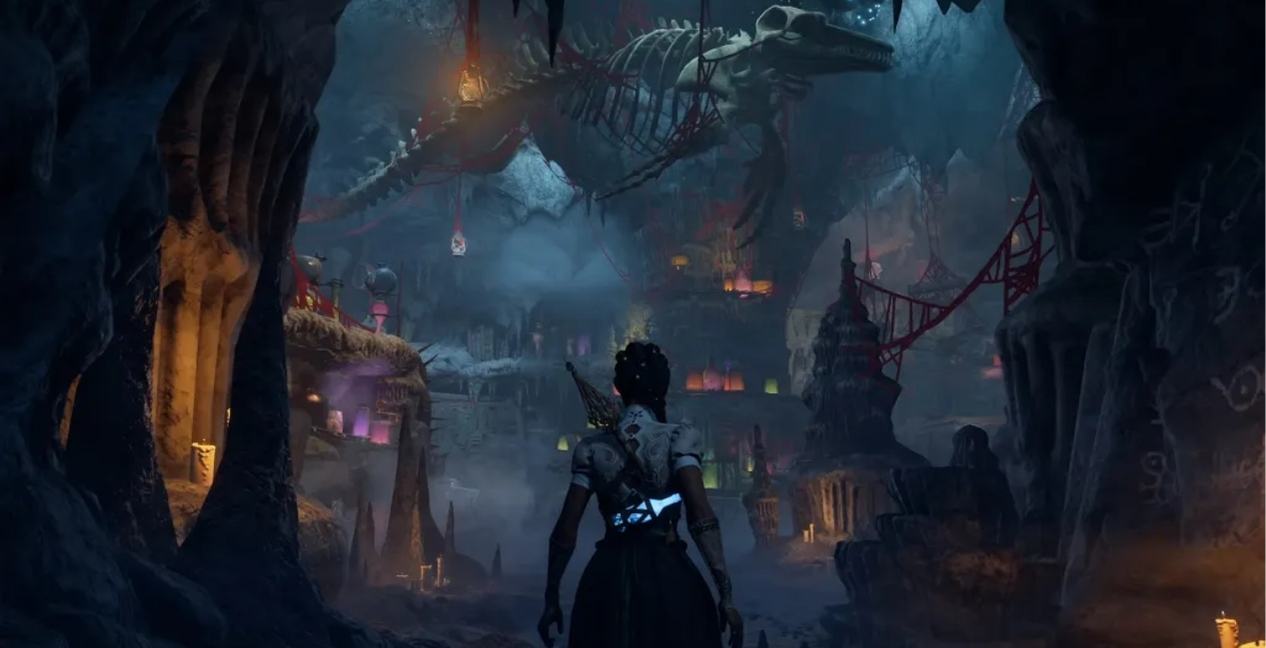
South of Midnight taps into unique sounds of the South and the genres of music it popularized, from bluegrass to jazz, and of course, the blues. There is a love in this game that runs deep and sees the subtleties of the South as precious idiosyncrasies that need to be captured in art.
Aside from the score and soundtrack, the sound design in South of Midnight also uses subtle moments to bring home the haunting atmosphere, which becomes a hallmark of the game. Often, when you use the guiding stand to find your next objective, you’ll hear a faint “Hazel,” a small calling of your name that you can’t place. It beautifully showcases Hazel’s connection to the world and the Grand Tapestry. It’s a small effect that does more than any dialogue that’s there to provide exposition.
Across its story, sound design, and entire artistic vision, South of Midnight is a gem of a game. While its combat loop is repetitive, the design behind it is substantial. Ultimately, Compulsion Games has created a love letter to the South, to its beauty and its stories. The dark fairytale we see in South of Midnight is narratively one of the heaviest hitters I’ve played, and that’s something special.
South of Midnight
-
Rating - 9/109/10
TL;DR
Ultimately, Compulsion Games has created a love letter to the South, to its beauty and its stories. The dark fairytale we see in South of Midnight is narratively one of the heaviest hitters I’ve played, and that’s something special.



